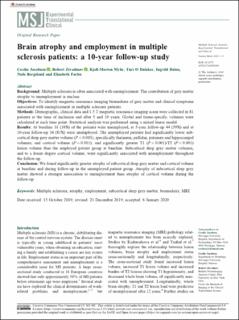Brain atrophy and employment in multiple sclerosis patients: a 10-year follow-up study
Jacobsen, Cecilie; Zivadinov, Robert; Myhr, Kjell-Morten; Dalaker, Turi Olene; Dalen, Ingvild; Bergsland, Niels; Farbu, Elisabeth
Journal article, Peer reviewed
Published version

Åpne
Permanent lenke
https://hdl.handle.net/11250/2763421Utgivelsesdato
2020Metadata
Vis full innførselSamlinger
- Department of Clinical Medicine [2066]
- Registrations from Cristin [9791]
Originalversjon
Multiple Sclerosis Journal, Experimental, Translational and Clinical. 2020, 6 (1). 10.1177/2055217320902481Sammendrag
Background: Multiple sclerosis is often associated with unemployment. The contribution of grey matter atrophy to unemployment is unclear.
Objectives: To identify magnetic resonance imaging biomarkers of grey matter and clinical symptoms associated with unemployment in multiple sclerosis patients.
Methods: Demographic, clinical data and 1.5 T magnetic resonance imaging scans were collected in 81 patients at the time of inclusion and after 5 and 10 years. Global and tissue-specific volumes were calculated at each time point. Statistical analysis was performed using a mixed linear model.
Results: At baseline 31 (38%) of the patients were unemployed, at 5-year follow-up 44 (59%) and at 10-year follow-up 34 (81%) were unemployed. The unemployed patients had significantly lower subcortical deep grey matter volume (P < 0.001), specifically thalamus, pallidus, putamen and hippocampal volumes, and cortical volume (P = 0.011); and significantly greater T1 (P < 0.001)/T2 (P < 0.001) lesion volume than the employed patient group at baseline. Subcortical deep grey matter volumes, and to a lesser degree cortical volume, were significantly associated with unemployment throughout the follow-up.
Conclusion: We found significantly greater atrophy of subcortical deep grey matter and cortical volume at baseline and during follow-up in the unemployed patient group. Atrophy of subcortical deep grey matter showed a stronger association to unemployment than atrophy of cortical volume during the follow-up.
